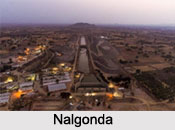 Cities of Telangana comprises of historical and mythological importance from ancient India. These cities are developed with modern infrastructure and well connectivity from all the cities of South India. Hyderabad is the capital city of Telangana and connected with other cities like Medak, Mahbubnagar, Nalgonda, Khammam, Warangal, Karimnagar, Adilabad and Nizamabad. Cities of Telangana are linked with 16 National Highways, South Central Railway Zone, Rajiv Gandhi International Airport, Nizamabad Airport, Warangal Airport and Ramagundam Airport.
Cities of Telangana comprises of historical and mythological importance from ancient India. These cities are developed with modern infrastructure and well connectivity from all the cities of South India. Hyderabad is the capital city of Telangana and connected with other cities like Medak, Mahbubnagar, Nalgonda, Khammam, Warangal, Karimnagar, Adilabad and Nizamabad. Cities of Telangana are linked with 16 National Highways, South Central Railway Zone, Rajiv Gandhi International Airport, Nizamabad Airport, Warangal Airport and Ramagundam Airport.
Hyderabad, Deccan Region
Hyderabad is the South Indian capital city of the Indian state of Telangana and it is considered as the fourth most populous city in India. Here Falaknuma Palace, Charminar, Mecca Masjid, Salar Jung Museum, Tankbund Park and many others are tourism destinations.
Warangal, Warangal District
Warangal is known for the Toranas of Kakatiya Dynasty, as it was the capital of early medieval era and eye witnessed sculptural elegance in Warangal Fort, Thousand Pillar Temple and Ramappa Temple.
Nizamabad, Nizamabad District
Nizamabad is the third largest city of north Telangana with best health care units and medical colleges.
Karimnagar, Karimnagar District
Karimnagar is a modern city, comprised of many Hindu temples like Vemulawada, Dharmapuri, Kondagattu, Kaleshwaram and many other places.
Ramagundam, Peddapalli District
Ramagundam, known as "City of Energy", generates its economy from coalfields of Godavari River Basin and the Ramagundam Super Thermal Power Station.
Khammam, Khammam District
 Khammam is developed near the Munneru River, a tributary of Krishna River, with Khammam Fort, Lakaram Lake, Bhadrachalam, Parnasala, Nelakondapalli and Kusumanchi.
Khammam is developed near the Munneru River, a tributary of Krishna River, with Khammam Fort, Lakaram Lake, Bhadrachalam, Parnasala, Nelakondapalli and Kusumanchi.
Mahabubnagar, Mahbubnagar district
Mahabubnagar is popular for the diamonds of Golconda and it is considered as the 7th most populous city in Telangana.
Nalgonda, Nalgonda District
Nalgonda has its existence from the Stone Age and it was the centre of politics during the time of different rulers of various dynasties like Mauryas, Satavahanas, Ikshvakus, Chalukyas and Rashtrakutas.
Adilabad, Adilabad District
Adilabad gained its popularity when it came under Qutub Shahis Dynasty and Asaf Jahis Dynasty. This city has connectivity with the tourism destinations like Kuntala Waterfall, Pochera Falls, Kawal Wildlife Sanctuary and Shivaram Wildlife Sanctuary.
Suryapet, Suryapet District
Suryapet known as the Gateway of Telangana, comprised of the rich history of Chalukyas, Kakatiyas, and finally Nizams of Hyderabad. Pillalamarri Temples have the intricately carved stone pillars, which stand as a testimony of the art and architecture.
Miryalaguda, Nalgonda District
Miryalguda is dependent on agriculture and the agro based industries. The new market at Miryalguda enhances the trade in rice to the national and international rice market.
Siddipet, Siddipet District
Siddipet is geographically located near the Siddipet revenue division and takes the water supply from Komati Cheruvu, Narsapur Cheruvu and Yerra Cheruvu.



















